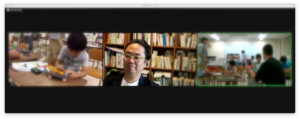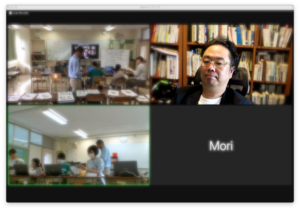
On November 6-7, we held our second remote class (workshop) on creating works that run with computers and programs at a special needs classroom in Hachioji City. This time, too, we divided the class into two groups, one for lower grades and the other for upper grades, for a total of five 2-hour sessions. As before, the younger students used programmable batteries and the older students used PICO Cricket. This time, we also added a sample of a mechanism to change the movement of a motor into various movements such as up, down, left, right, and so on. Some of the children tried to evolve their previous works, while others tried to create works utilizing the newly prepared mechanisms. Recently, I have often ended a workshop with only a two-hour experience, but this was an opportunity for me to rethink the importance of the second time around.
Using familiar tools, rather than completely new ones, naturally broadens the ideas for creating works of art. Furthermore, the sense of security of using tools that they know and are familiar with seemed to make the children’s artwork creation itself a safe activity.

I would like to introduce some of my previous practices here regarding learning through digital manufacturing that is created after becoming familiar with the tools.
In classes and workshops on programming and other computer-based digital manufacturing, children learn not only programming knowledge and skills, but also various other things. I can feel this every time I am in the workshop. How can we evaluate that, and in this practice, we have tried to do so.
More than 10 years ago, I conducted a class using Scratch and PICO Cricket with Manabu Sugisawa, a teacher at Nara Women’s University Elementary School, for 4th graders. In this practice, we attempted to evaluate the students’ work by analyzing their works and the reports they wrote about them.
First, by using visual (block-type) programming tools, we found that the children created and used programs that included sequential and repetitive branching in their works.
The portfolio of the students’ works showed that each student had various insights not only about programming, but also about the design and structure of their works, collaboration with others in the production process, their own approach to the production activities, and changes in their views on computers and programmable objects around them. The children each had their own unique insights into the process of designing and programming their works.
The two-step design of the activity objectives and the circular design of the activities were the main innovations in the design of these lessons. In the two-step design of the activity goals, the first goal for all participating children is to learn how to use Scratch and PICO Cricket tools, which is set at the beginning of the class. In the subsequent creation of artworks, students set their own activity goals according to their own interests and the artworks they want to create. Specifically, the first few hours are used to familiarize themselves with the tools and try programming and creating simple works of art, and the rest of the time is used to set goals for the activities in which each student will create the work they want to create.
The second is the design of the activity cycle. We adapted Ueda’s (2005) workshop design model “Make, Talk, Reflect” and Resnick’s (2007) Creative Learning Spiral – imagine – create – play – share – reflect for school classes. In each class, children think about what they want to do, think about their goals and objectives, do the activities, reflect on the results, and share the results with the class. Finally, they come up with a plan of activities for the next time.
Each of these classes was a long, long-term practice of over 25 hours, so it was a slow, large cycle that took time to complete. It was also beneficial for the teachers to be able to think slowly about how to support each child the next time before the next class.
By conducting the workshop remotely, we were not able to obtain information using all five senses as in the field, but by concentrating on visual and auditory information to grasp what was happening in the field, we were able to see what was happening with the children that we had not seen (or could not see) before.
One of them is that the cycle of activities I mentioned earlier is progressing at a very fast pace. “I’ve got an idea! Look, teacher! I’m a genius,” and the next activity is already underway. In the blink of an eye, “imagine – create – play – share – reflect” is happening.
This was possible because the children happened to be working while speaking out loud, but in fact, there must be many children who are circulating activities without speaking out loud. Furthermore, since it is not manifested as an actual activity, we have to consider how we should evaluate this, but it is possible that the circulation of activities in the mind is happening in a short time and many times. You might call it a cycle of thought.
However, how to evaluate this momentary cycle of activity, both learners and teachers, may not be able to keep up with the speed of writing or verbalizing it, and forcing the process of reflection may stop the circulation. Forcing the process of reflection may stop the cycle.
The children’s “I’ve got an idea,” “Look at that,” and the confident smiles that follow are the moments I keep hoping will emerge during the workshop. I will continue to think about how to record and evaluate these events that occur suddenly and instantaneously, phenomena that in some cases do not appear as voices or body movements, in order to convey the advantages of the workshop as a place for learning.
